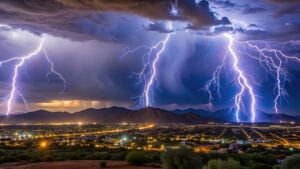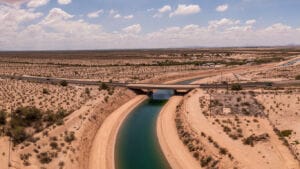Phoenix’s continuous temperature rise over the past several years has become a major environmental issue for the greater metropolitan area.
When pavement and cement structures are in high temperature areas they absorb and maintain heat, which becomes known as an urban heat island (UHI). It is a man-made problem and can impact the overall climate because the heat releases more slowly. Phoenix’s UHI continues to worsen with more urbanization and industrialization. There are many factors that contribute to the UHI impact in cities throughout the country, but bigger cities in warmer areas tend to suffer more.
Dr. Richard Rushforth, a Walton School of Sustainability Solutions Initiative Project Manager at Arizona State University, has been working with Phoenix’s Environmental Quality Commission on a greenhouse gas inventory. He currently works on a project to provide sustainable water to vulnerable and refugee host communities.
“The buildings absorb heat during the day and it stays, so the nights are warmer,” Rushforth said. “Essentially a dome of heat covers the greater Phoenix area.”
With lack of shade because of little to no vegetation throughout the city, it leads to an abundance of heat.
Living in the desert, most residents unintentionally have the misconception water quality would be the biggest concern. Water scarcity in desolate areas, such as Phoenix, generally remains the number one problem. However, water has not a big issue for 2016. Phoenix’s UHI remains mostly unmentioned.
Director of the Kyl Center for Water Policy Sarah Porter at the Morrison Institute for Public Policy at Arizona State University strives for ways to address Arizona’s natural resource challenges and find ways to combat Arizona environmental problems.
“[The UHI] is the number one problem,” Porter said. “It hurts low income homes much worse than affluent people. Low income people live in hotter places.”
The need for air conditioning and water for homes and offices to stay cool increases each summer, which in the ends costs more in the hotter areas.
Additionally, the UHI affects peoples’ abilities to go outside.
“We can’t have a walkable city,” Porter said. “Kids can’t play outside which affects children’s health. There is too much impermeable surface.”
According to 12News, Phoenix is the hottest city in the United States. To account for southern Arizona’s natural desolate climate, efforts need to be taken as Phoenix continues to grow.
Sonoran Institute Sun Corridor Program Director Ian Dowdy believes Phoenix is one of the hottest cities in the world and has been working with the Sun Corridor Legacy Program for three years in finding solutions to protect the natural region. He currently leads a number of projects, one of which includes invigorating resilient urban communities.
“Places with more vegetation have lower obesity and less asthma in children,” Dowdy said. “Those places have a better environment, which is a given… people will go out more when they have shaded sidewalks. We need to figure out a way to deal with it.”
The underlying issue of water used to prevent to cool off the city because of the UHI could only make the situation worse. The biggest challenge would be to manage the tradeoff between cooling irrigated surfaces and finding a way to secure the water required.
“Affluent communities use about 50,000 gallons of water,” Dowdy said. “North Scottsdale and Paradise Valley use eight to 10 thousand gallons less.”
Arizona State University’s School of Sustainability and the city of Phoenix have created projects and plans to combat this complex issue that continuously affects greater Phoenix.



